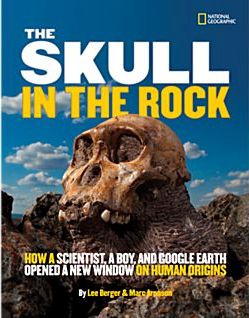Books That Explore Our (Very Distant) Past: Ancient skulls and skeletons can tell us about ourselves | Nonfiction Booktalker
I love staring at faces in old photos and trying to guess who those sepia-tinted people were. The authors of the following books have the same habit, but they go deeper and further back in time. They uncover bones, skulls, and whole skeletons. Do you think your fifth- to eighth-grade audience would want to see the face of a two-million-year-old teenager? Then dig this.
 Lee R. Berger and Marc Aronson’s The Skull in the Rock: How a Scientist, a Boy, and Google Earth Opened a New Window on Human Origins (National Geographic, 2012) opens with the discovery of an ancient shoulder bone of a nine-year-old male. That bone led scientists to the nearly complete skeleton of a creature older than any previously found, and possibly an ancestor of modern man. Not Early Man, but Early Boy! Berger had been scouring South Africa for years, but his insight that Google Earth could help him identify sites of ancient caves proved to be a startling technological leap.
Lee R. Berger and Marc Aronson’s The Skull in the Rock: How a Scientist, a Boy, and Google Earth Opened a New Window on Human Origins (National Geographic, 2012) opens with the discovery of an ancient shoulder bone of a nine-year-old male. That bone led scientists to the nearly complete skeleton of a creature older than any previously found, and possibly an ancestor of modern man. Not Early Man, but Early Boy! Berger had been scouring South Africa for years, but his insight that Google Earth could help him identify sites of ancient caves proved to be a startling technological leap.
Even more startling was his Sherlock Holmes-like deduction that another early child skeleton he had studied had probably been killed by an eagle. Show your audience the pictures on pages 28–29. Would they have come to the same conclusion as Berger?
Thousands of years ago, two young men wading in the Columbia River near Kennewick, WA, made their own discovery that caused one of them to smile. He saw a skull-shaped rock and picked it up to play a trick on his friend. Then he realized it was a real skull! Sally M. Walker and Douglas W. Owsley’s Their Skeletons Speak: Kennewick Man and the Paleoamerican World (Carolrhoda, 2012) details how this single object created a rippling effect of problems. Native Americans claimed the 9,000-year-old skull as an ancestor, while scientists wanted to keep it for further study.
The scientists won some time, but then they learned something that no one had expected. The skull didn’t belong to any Native American group. So where was it from? As the authors introduce us to other prehistoric American skeletons, we learn how hard the lives of ancient people were. Imagine having your teeth worn down to the gum line. How useless they must have been and how much they must have ached.
James M. Deem’s Faces from the Past: Forgotten People of North America (Houghton, 2012) not only describes faces from thousands of years ago to the early 1900s, but also tells us exactly how the artful science of facial reconstructions is performed, with work-in-progress examples. To a face fanatic like me, this book is a visual feast.
What do we learn from the skulls of soldiers whose bodies were left to rot on the battlefield of San Jacinto in 1836 Texas? And who even thought to collect them? It was bird-lover John James Audubon who picked up four of them as a gift for a collector friend in Philadelphia. Who knew there were skull collectors? Yuck.
Deem reconstructs the lives of those buried in the Almshouse Cemetery in Albany County, NY. The poorest of the poor are buried with convicts from the nearby penitentiary and drowning victims retrieved from the Hudson River. Poor as they may have been, life in the Almshouse was an improvement—the skimpy food, horrible living conditions, and lack of stimulating activities were better than starving to death or living without shelter. The riveting facial reconstructions reveal their lost lives: bad teeth often led to death, a common revelation of many ancient skulls. Maybe we aren’t grateful enough for modern dentistry!
Stare at the face of a French sailor from 1686, or of a Buffalo Soldier, a Chinese miner, or a lost Monacan Indian. The stories go on and on. And they can all be seen in people’s faces. Without saying a word, these skulls and skeletons tell us much about ourselves. Ask your booktalk audience, What does your face say about you?
Stare into these books. You might just find yourself staring back.
RELATED
The job outlook in 2030: Librarians will be in demand
The job outlook in 2030: Librarians will be in demand
ALREADY A SUBSCRIBER? LOG IN
We are currently offering this content for free. Sign up now to activate your personal profile, where you can save articles for future viewing






Add Comment :-
Comment Policy:
Comment should not be empty !!!
Jennifer Emmett
I dig this article, Kathy!Posted : Feb 21, 2013 04:19